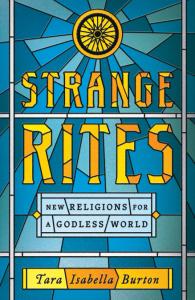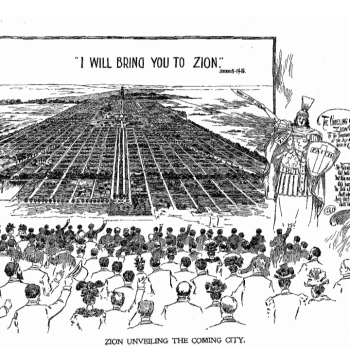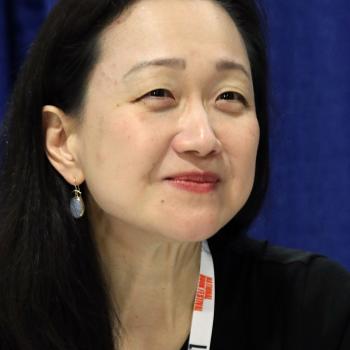Sleep No More was different. You didn’t just watch a show or read a book or even write a blog. You got to participate. You got to touch people. You got to go inside a magical world, discover symbolic connections, find meaning. Almost unanimously, the superfans I interviewed cited the power of living … in an enchanted place: a world where everything, even the design of a room or the arrangement of dead flowers or the cards on a table, had symbolic weight.
 For Tara Isabella Burton and hundreds or thousands of others, the McKittrick theater was a home, a “therapy session,” a “bordello,” and, “yes, a church.” In Strange Rites: New Religions for a Godless World, Burton argues that young Americans are not discarding religion. They are “remixing it.” In their search for meaning, purpose, community, and rituals, they find spiritual paths they regard as authentic. And they find them in yoga studios, fitness classes, and atavistic far-right and hyper-masculine Internet communities. In those places, in those communities, they experience the “collective effervescence” that Emile Durkheim saw at the center of religion.
For Tara Isabella Burton and hundreds or thousands of others, the McKittrick theater was a home, a “therapy session,” a “bordello,” and, “yes, a church.” In Strange Rites: New Religions for a Godless World, Burton argues that young Americans are not discarding religion. They are “remixing it.” In their search for meaning, purpose, community, and rituals, they find spiritual paths they regard as authentic. And they find them in yoga studios, fitness classes, and atavistic far-right and hyper-masculine Internet communities. In those places, in those communities, they experience the “collective effervescence” that Emile Durkheim saw at the center of religion.
There is something happening here, but what it is ain’t exactly clear. Or at least not fully. “Religion in America is in a free fall,” Burton observes. Younger generations of Americans are leaving the religious institutions of their parents in droves, and not just progressive and mainline institutions. The evangelical denominations that thrived while the mainline started to collapse in the 1960s are now undergoing their own collapse.
Burton maintains that young Americans are abandoning “ordinary, traditional religion” for “new gods.” They find them in wellness centers, BDSM communities, witch culture, and Jordan Peterson videos. And older civil religions have also collapsed. Burton sees three new impulses battling for supremacy within this post-traditional religious landscape: “the techno-utopians’ dream of a world in which we are all rendered optimally efficient machines, the social justice utopia of a liberated world, the atavists’ vision of a purifying cataclysm that will bring us beyond the tyranny of civilization altogether.”

Strange Rites made me feel really antiquated. Here I am, going to my Presbyterian church watching my Presbyterian church on our basement couch. I hope to be saved, not made temporarily “well.” I don’t have a sign in my front yard proclaiming my welcome to all potentially unwelcome peoples. I haven’t read any of Jordan Peterson’s book. I never made it to the Rocky Horror Picture Show, let alone to the McKittrick. I’m totally grateful that Burton has investigated these things, and I feel much better educated about the society in which I live after reading Strange Rites. In all seriousness, Burton has a sharp eye for detail, and her portraits of these phenomena are engrossing. She also connects the present to the past effectively, sketching the antecedents of contemporary trends in the New Thought and Social Gospel movements of the past.
And yet, I’m skeptical of her argument that the sum total of these developments represents religion remixed rather than religion discarded.
Burton leans heavily on Durkheim’s understanding of religion as “a unified system of beliefs and practices which unite in one single moral community called a Church all those who adhere to them.” It doesn’t matter whether the group equates the sacred with “God” or with something else. In the end, the community – or clan or fitness group – is the sacred. New religions are formed through moments or times of “collective effervescence” and sustained through rituals that connect them to that originating vision.
While no one can claim to be the definitional god of religion, my own current preference is for Robert Orsi’s suggestion (from his Between Heaven and Earth) that a religion is “a network of relationships between heaven and earth involving humans of all ages and [often] many different sacred figures together.” One could fit some of Burton’s examples into this framework, especially if one leaned on the “often” and had a capacious understanding of “heaven.” On the other hand, some of her other examples wouldn’t even fit into Durkheim’s definition. As she observes, “Wellness begins – and ends – with the self.” And it goes without saying that whatever the flaws in more traditional religious communities, those communities have proven far more durable than the movements in Strange Rites.
This is how I resolve this definitional question. There is a difference between resembling religion and religion itself. It is one thing to say that gameday at your typical SEC or Big Ten (really, 14) school includes many elements of religion: rituals, a pantheon of saints, sacred symbols, hymns, and so forth. And collective effervescence in spades. “In the South,” many commentators will say, “football is a religion.” Such comments, though, are usually tongue in cheek. There’s a difference between being a sports fan – or part of Harry Potter fandom, which Burton discusses – and belonging to a religious community. Most folks going to a Michigan football game, or to their fitness class, or to their Internet chat room don’t think of those activities as their religions, even if they might recognize spiritual elements within them.
Humans beings will always seek purpose, meaning, and community. And those communities will create rituals. But in many cases, people today are leaving religion behind, rather than remixing it. The “new gods” in Strange Rites are, perhaps, not really gods at all, but something else entirely.













